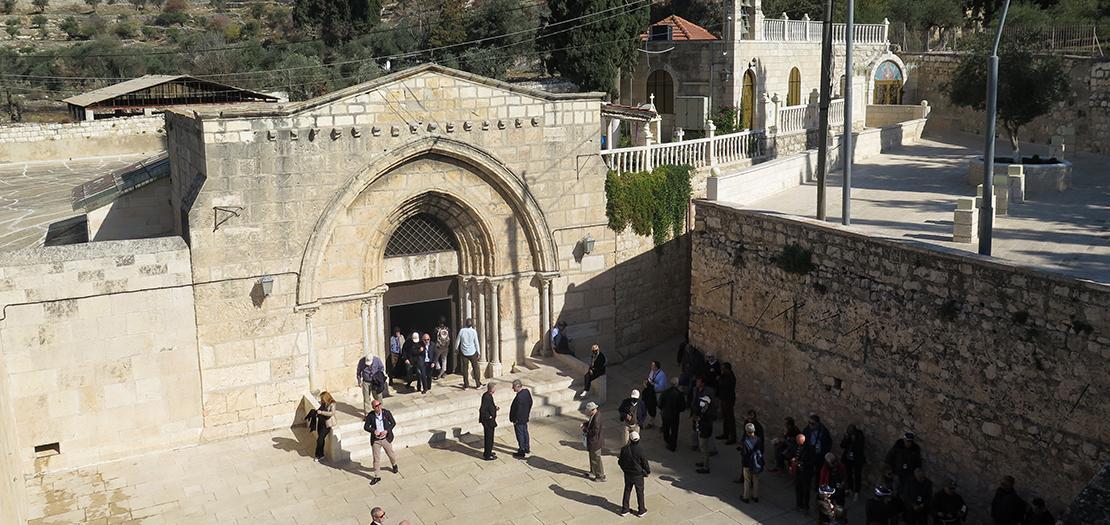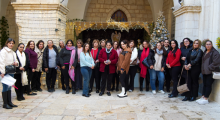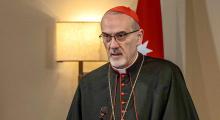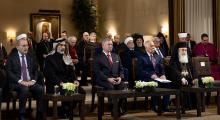Issued by the Catholic Center for Studies and Media - Jordan. Editor-in-chief Fr. Rif'at Bader - موقع أبونا abouna.org

For Christians, the date of August 15 is not a feast like the others. In fact, it celebrates the Assumption of Mary into Heaven, one of the four Marian dogmas of the Catholic Church. Proclaimed by Pius XII on November 1,1950, the Assumption dogma has its origins in Sacred Scripture. And in Jerusalem, still today, one can behold and "touch" some of the elements which led to the publication of the "Munificentissimus Deus" Apostolic Constitution nearly seventy-five years ago.
In the Holy City, as Father Claudio Bottini - professor emeritus with the Faculty of Biblical and Archaeological Sciences of the Studium Biblicum Franciscanum of the Holy Land - recalls, "the feast of the Assumption is celebrated on two different dates: Christians belonging to the Latin Church, that of Rome, celebrate it on August 15, as per the usual calendar. Then, there are the Orthodox, along with Armenians, Copts, Syrians who celebrate the Assumption on a different date, in accordance with the Julian calendar. "
For all Christians in the Holy Land, the friar notes, the Assumption is "the most heartfelt feast after Easter. During these days, believers express their fervor and faith through liturgies and processions ". In part, such large participation is due "to the summer weather which favors a large number of partakers. But – Father Bottini goes on – in Jerusalem, such nourished processions, which catch everyone's attention, are only ever seen for the rites of Holy Week and the Assumption."
These acts of popular devotion meander through the streets which connect two points of the city, or better, two churches: the one known as Dormitio Virginis, on Mount Zion, where the Christian community believes that Our Lady "fell asleep in death"; and the one of the "tomb of Mary", erected in the cemetery area of the Kidron valley where, according to Jewish tradition, the Final Judgment will take place.
"The excavations carried out in the 1970s – the friar recounts – confirm the description contained in the tradition's stories and in some popular writings dating back to the second century AD". These excavations began after a flood that completely inundated the church built on the site where, as tradition would have it, the empty tomb of Our Lady lay, near Gethsemane. The damage caused by nature forced the Orthodox Greeks and Orthodox Armenians, the sanctuary's custodians, to dismantle all the superstructures that hid Mary's tomb and undertake restoration work.
"Thanks to this ecumenism of small and silent gestures – the professor explains –, the Orthodox invited Father Bellarmino Bagatti, the dean of Franciscan archaeologists in the Holy Land, to visit and study the tomb and the sepulchral and architectural complex around it. But Bagatti didn't just examine the monument. He ‘reread’ it carefully in light of the ancient literature on the death and burial of the Madonna".
The New Testament speaks of Mary for the last time after the Ascension of Jesus, presenting her as surrounded by the Apostles and the early Christian community (see Acts 1, 14). "No canonical text – Bottini points out – tells us how Mary spent her last years and how she left the Earth. Several writings entitled cycle on the Dormition of Our Lady, very widespread in the Christian world, transmit a whole set of information that, having being vetted by historical and theological criticism, proved to be of the utmost importance". These texts are apparently "all attributable to an original document, a Judeo-Christian prototype drawn up around the second century in the context of the Mother Church of Jerusalem, for the annual liturgical commemoration at the Virgin's tomb. In the redaction of the Dormition attributed to the Evangelist Apostle John, called the Theologian, it says: "... the apostles carried the gurney and laid her holy and precious body in a new tomb in Gethsemane". In another text, preserved in Syriac, are even more precise topographical indications: "This morning take Lady Mary and go out of Jerusalem on the road which leads to the head of the valley past the Mount of Olives, there are three caves: a larger outer one, then another inside and a small inner chamber with a raised clay bench in the east. Go and put the Blessed One on that bench and put her there and serve her until I tell you so. "
With the verification of the facts, Father Bagatti "showed that the accordance between the document and the monument could not be greater. Indeed, the tomb of Mary in Gethsemane – the professor points out – is located in a cemeterial area in use in the first century. It corresponds very well both to the type of tombs used in Palestine at the time, and to the topographical data mentioned in the different editions of the Dormition of the Virgin, especially regarding the new burial chamber and its position with respect to the others. The fact that it is located next to the Garden of Olives and the cave where Jesus would spend the night, suggests that the anonymous disciple who owned the area also accepted Mary's burial therein. The tomb, guarded and venerated by the Judeo-Christians until the end of the fourth century, when it passed into the hands of the gentile Christians, was isolated from the others and enclosed within a church".
Today, of the different churches erected on site over the centuries, "there remains the crypt that by way of a large forty-eight-step staircase leads to the tomb, about fifteen meters above street level. The aedicule enclosing the burial chamber with its rocky bench still visible, is barely illuminated by the oil lamps and by the light that comes in from the outside. Inside one can inhale the typical atmosphere of oriental churches characterized by the strong smell of incense, numerous images and many candles and oil lamps ".
"Those who visit these places feel something special within themselves. In accompanying men of culture or journalists to these places, they themselves realize, even if they are non-believers, that they are before something serious. You can't speak of veritable conversions, but everyone remains awed,"Bottini reveals.
But how do Catholics spend the feast of August 15? "First they celebrate Mass in the Basilica of Gethsemane, better known as the Basilica of the Nations. Then, in procession they go to the church of the tomb, descend into the crypt and pray with songs and hymns". The most attentive eyes have spotted that in the crypt where the empty tomb is, lies a nook: "Muslims have used and still use it – the professor explains –. In the past, many Islamic groups used to visit the tomb, now they do it privately. Mary is an important figure for them too, and the nook is facing Mecca".
Christians belonging to the Eastern Churches also celebrate the feast in this place: "For eight days Eastern Christians descend into the crypt every day carrying children, the elderly and the disabled. The tomb is decorated with aromatic herbs, such as basil, and they pray in front of the icon of the Dormitium which is usually found in the basilica of the Holy Sepulchre. The icon is solemnly carried in procession to the tomb and returned to its place, again in procession. And it's like a big party. ”
A feast that this year, on account of the war that continues to tear through the Holy Land, "will be in a minor key. But as in the past, the celebration will be held ", Father Bottini concludes. “I've seen so many crises in this country. Everything happens on a smaller scale, but it does not cancel out. The feast of the Assumption will be celebrated as it was for Easter. These are tragic moments, but one is able to pray with greater intensity. In these more collected celebrations, as we always do, we shall pray for the return of the pilgrims and above all for peaceful solutions. Not just for our home, but for the world too. And we will do it twice, given the two dates in the Julian and Gregorian calendars. Men are capable of atrocious things, but here are many people of good will who keep on believing, hoping and praying for a better world. It is a seed of hope that will surely grow."







